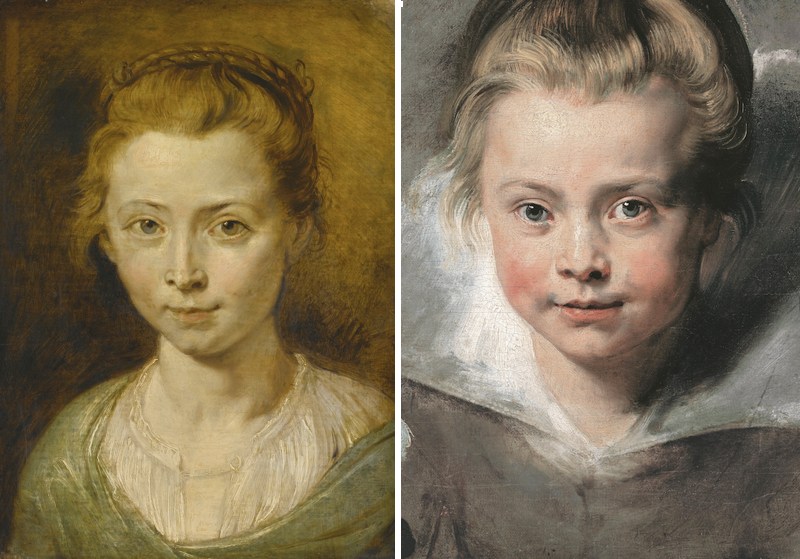THE heavy curtains at the entrance to the exhibition were like any you would find at the front door of a family home. Designed to keep out drafts, they also concealed the private and intimate world of its former occupants. When pulled back, there was a sense of the warm atmosphere that was once a part of everyday life in this house in Antwerp. This was important by way of introduction to the stunning portraits in the Rubens in Private: The Master Portrays his Family.
We were standing in the former palatial home of Peter Paul Rubens (1577-1640), who spent many happy years here with his first and second wives and his eight children. As in any home today, the portraits of family and friends that line the walls were not intended for public display. The Flemish painter created them as keepsakes, a sort of family album, which means they are much freer than his commissioned portraits of nobility, and give a unique glimpse into his life and his affection for his loved ones.
It is the first time in nearly 400 years, the portraits are back home in the place where they were created, albeit temporarily. The family reunion is thanks to more than 50 loans from all over the world, which include the British Museum in London, the Musee du Lovure in Paris and the Queen’s Royal Collection. What is noticeable is how small many of these masterpieces are by comparison to his vast biblical, historical and allegorical works, and, of course, the voluptuous nudes, for which he is well known.
Ironically, Rubens was not particularly fond of portraiture as a genre, yet he was one of the best portrait artists of his time. One of the most captivating and tender paintings is of his five-year-old daughter Clara Serena (below right), who was his eldest child from his first marriage to Isabella Brant. The key aspect of the work, dating from around 1616, is the close-up of her smiling face and the way she looks directly at the viewer, or rather her father.
It is extraordinary how Rubens’ use of colour and oil captures her delicate features, from her rosy cheeks and fair hair to her asymmetrical eyes, one has a slight squint. He seems only interested in her beautiful face as her clothes lack fine detail; this is probably because he never intended to sell it. His affection for his daughter is what makes the portrait so personal, as well as universal. It is also particularly poignant because Clara Serena died just seven years later, in 1623, at the age of 12.
People queued up to see her timeless gaze. It had been thought it was the only remaining original painting of her. However, experts at the Rubens House, which is now a museum and study centre, recently announced that after painstaking research a second portrait of Clara Serena, initially thought to be a copy, is a work of Rubens. The oil on wood also hangs in the exhibition and experts believe it was painted just before or after she died. It is on loan from the Prince of Liechtenstein’s collection (above left).
The master’s love for his family also radiates out in the intimate portraits of his adored wives and his seven other children. He married Isabella (above right)in 1609 and where he paints her smiling, there’s a suggestion she is sharing a private moment with him. The knowing looks are also captured in the portraits of Helena Fourment (above left), who he married four years after Isabella died in 1626. Rubens, who was 53, described his 17-year-old bride, as the “the most beautiful girl in Antwerp”. The famous portrait of her wearing nothing but a fur wrap was painted on wood and is too fragile to be transported to the exhibition. A copy hangs on the wall.
The three self-portraits give an insight into Rubens at different stages in his life. He was a classically trained scholar, who spent years studying and copying masterpieces from the Italian Renaissance. In addition to running his large art studio, where he produced paintings for nobility, as well as tapestries, engravings and drawings, he was also a diplomat, who was knighted in England and Spain. The oil on wood, which he painted in 1623 at the age of 45, was probably ordered by the future Charles I, the Prince of Wales. In the painting, which is on loan from the Queen, Rubens does not portray himself as an artist, but rather shows off his social status as a wealthy, dignified and confident aristocrat. A later portrait of him emerging from a dark background candidly shows how he has aged.
There has been massive interest in the Rubens in Private: The Master Portrays his Family exhibition both nationally and internationally – 15,000 advanced tickets were sold before it opened last month. It starts appropriately with portraits of his grandparents, Bartholomeus Rubens and Barbara Arents, painted by Jacob Claesz van Utrecht for their wedding in 1530. The portraits also include his beloved brother Philip (below right).
The Rubens House is a good starting point for exploring the master painter’s enormous influence on Antwerp, a beautiful medieval city in Belgium. There is a three-hour guided Rubens walk, which includes nearby St James’s Church in the city centre, where he attended mass with his family and where he is buried. His magnificent Madonna with the Saints hangs above the altar. There are also three epic masterpieces in the Cathedral of Our Lady, namely The Raising of the Cross (1610), The Descent from the Cross (1614) and above the high altar, the painting The Assumption of the Virgin (1626).
However, it is in the intimate surroundings of his house, where Rubens died in 1640, aged 62, where his presence is most felt. The portraits illustrate his skill as a master painter but, importantly, they also reveal how Rubens in private was a loving husband, father, brother, son and friend.
The curtain closes on the exhibition on June 28.
FACT BOX
Admission to the Rubens in Private: The Master Portrays his Family exhibition is E10 adults, E8 for 12-25 years and free for under 12. (rubenshuis.be)
Mary stayed at the Travelodge conveniently situated next to London City Airport. Rooms start at £29 a night. (Travelodge.co.uk)
Antwerp is just under an hour by plane from London City Airport on CityJet (cityjet.com) and over three hours in total by Eurostar (eurostar.com) from London St Pancras International and a connecting train.
For details about the Rubens Walk go to visitantwerpen.be
For more information on travelling to Belgium visit www.visitflanders.com




